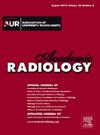Low-dose Ultra-high-resolution Photon-Counting Detector CT for Visceral Artery CT Angiography: A Preliminary Study
IF 3.8
2区 医学
Q1 RADIOLOGY, NUCLEAR MEDICINE & MEDICAL IMAGING
引用次数: 0
Abstract
Rationale and Objectives
To validate the image quality of low-dose ultra-high-resolution (UHR) scanning mode of photon-counting detector CT (PCD-CT) for visceral artery computed tomography angiography (CTA).
Material and Methods
We prospectively enrolled 57 patients each in the full dose (FD) and low-dose (LD) protocols, respectively, to undergo abdominal CT scans using the UHR mode on a PCD-CT system (NAEOTOM Alpha), between April 2023 and September 2023. Both the FD data and LD data were then reconstructed into two series of images: (a) 0.2 mm slice thickness, reconstruction kernel Bv48, quantum iterative reconstruction (QIR) 4; (b)1 mm slice thickness, Bv40, QIR 3. The signal-to-noise ratios (SNRs) and contrast-to-noise ratios (CNRs) of seven arteries were objectively measured. The image noise, vessel sharpness, overall quality, and visibility of nine arteries were subjectively assessed by three radiologists.
Results
The SNRs and CNRs of 0.2 mm reconstruction set was inferior to that of 1 mm reconstruction set (p < 0.001 for all the arteries and noise), however, the image quality of 0.2 mm reconstruction set was higher than that of 1 mm reconstruction set in qualitative evaluation especially for tiny arteries in Volume-rendered (VR) image (p < 0.001). The SNRs and CNRs were not significantly higher for FD group than LD group on the same slice thickness except for SNRs of common hepatic artery, splenic artery and bilateral renal arteries in 0.2 mm reconstruction set. In the comparison on image quality between normal weight and overweight patients within the same reconstruction set, the results showed that low-dose scan did not significantly impact the image quality in overweight patients. The ratings of visibility of nine visceral arteries were not significantly different among FD and LD at the same thickness reconstruction set except for superior mesenteric artery (p = 0.002 and 0.007 for 0.2 mm and 1 mm reconstruction set in axial image; p = 0.002 and 0.007 for 0.2 mm and 1 mm reconstruction set in coronal image, respectively) and left gastric artery (p = 0.002 and p < 0.001 for 0.2 mm and 1 mm reconstruction set in VR image, respectively).
Conclusion
The low-dose UHR scanning mode of PCD-CT has proven to be adequate for the clinical evaluation of visceral arteries. Utilizing a reconstruction with a slice thickness of 0.2 mm could enhance arterial depiction, particularly for small vessels.
用于内脏动脉 CT 血管造影的低剂量超高分辨率光子计数探测器 CT:初步研究。
原理和目的:验证用于内脏动脉计算机断层扫描(CTA)的光子计数探测器 CT(PCD-CT)低剂量超高分辨率(UHR)扫描模式的图像质量:2023年4月至2023年9月期间,我们分别以全剂量(FD)和低剂量(LD)方案前瞻性地招募了57名患者,在PCD-CT系统(NAEOTOM Alpha)上使用UHR模式进行腹部CT扫描。然后将 FD 数据和 LD 数据重建为两组图像:(a) 0.2 毫米切片厚度,重建内核 Bv48,量子迭代重建(QIR)4;(b) 1 毫米切片厚度,Bv40,QIR 3。客观测量了七条动脉的信噪比(SNR)和对比度-信噪比(CNR)。三位放射科医生对九条动脉的图像噪音、血管清晰度、整体质量和可见度进行了主观评估:结果:0.2 毫米重建集的 SNR 和 CNR 均低于 1 毫米重建集(P事实证明,PCD-CT 的低剂量 UHR 扫描模式足以用于内脏动脉的临床评估。使用切片厚度为 0.2 毫米的重建可增强动脉描绘,尤其是对小血管的描绘。
本文章由计算机程序翻译,如有差异,请以英文原文为准。
求助全文
约1分钟内获得全文
求助全文
来源期刊

Academic Radiology
医学-核医学
CiteScore
7.60
自引率
10.40%
发文量
432
审稿时长
18 days
期刊介绍:
Academic Radiology publishes original reports of clinical and laboratory investigations in diagnostic imaging, the diagnostic use of radioactive isotopes, computed tomography, positron emission tomography, magnetic resonance imaging, ultrasound, digital subtraction angiography, image-guided interventions and related techniques. It also includes brief technical reports describing original observations, techniques, and instrumental developments; state-of-the-art reports on clinical issues, new technology and other topics of current medical importance; meta-analyses; scientific studies and opinions on radiologic education; and letters to the Editor.
 求助内容:
求助内容: 应助结果提醒方式:
应助结果提醒方式:


